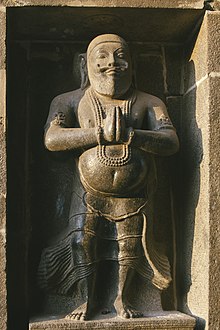| Kulottunga I | |||||
|---|---|---|---|---|---|
| Rajakesarivarman, Chakravartigal, Rajanarayana, Tribhuvana Chakravartigal, Konerinmaikondaan, Sungam Thavirtha Cholan, Jayadhara, Virudarajabhayankara | |||||
 Sculpture of Kulottunga I at Nataraja Temple. | |||||
| Chola emperor | |||||
| Reign | June 1070 – 1122[1] | ||||
| Predecessor | Athirajendra | ||||
| Successor | Vikrama | ||||
| Eastern Chalukya King | |||||
| Reign | c. 1061 – c. 1118 | ||||
| Predecessor | Rajaraja Narendra | ||||
| Successor | Vikramaditya VI | ||||
| King of Kadaram | |||||
| Reign | c. 1070 | ||||
| Predecessor | Athirajendra | ||||
| Successor | Position abolished (Tribhuwanaraja as king of Melayu) | ||||
| |||||
| Reign | c. 1070 (few months) | ||||
| Predecessor | Athirajendra | ||||
| Successor | Vijayabahu I | ||||
| Born | Rajendra Chalukya 1025 Chelluru, Vengi, Chola empire ( modern day Rayavaram, Andhra Pradesh, India) | ||||
| Died | 1122 (aged 96–97) Gangaikonda Cholapuram, Chola empire (modern day Jayankondam, Tamil Nadu, India) | ||||
| Empress | DinaChintamani[2] Madurantaki Thyagavalli Elisai Vallabhi Solakulavalliyār | ||||
| Issue |
| ||||
| |||||
| Dynasty | Chola (mother's side) Eastern Chalukya (father's side) | ||||
| Father | Rajaraja Narendra | ||||
| Mother | Amangai Devi | ||||
| Religion | Hinduism | ||||
| Signature | |||||
Kulottunga Chola I (/kʊˈloʊtʊŋɡə/; Middle Tamil: Kulōttuṅka Cōḻaṉ; Classical Sanskrit: Kulottuṅgā Cōḷa; 1025–1122) also spelt Kulothunga (lit. 'The Exalter of His Clan'), born Rajendra Chalukya (Telugu: Rājēndra Cāḷukyuḍu), was a Chola Emperor who reigned from 1070 to 1122 succeeding his cousin Athirajendra Chola.[5] He also served as the Eastern Chalukya monarch from 1061 to 1118, succeeding his father Rajaraja Narendra.[6][7] He is related to the Chola dynasty through his mother's side and the Eastern Chalukyas through his father's side. His mother, Ammangaidevi, was a Chola princess and the daughter of emperor Rajendra Chola I. His father was king Rajaraja Narendra of the Eastern Chalukya dynasty who was the nephew of Rajendra and maternal grandson of Rajaraja Chola I. According to historian Sailendra Nath Sen, his accession marked the beginning of a new era and ushered in a period of internal peace and benevolent administration.[8] He was succeeded by his son Vikrama Chola
Kulottunga had diplomatic relations with the northern Indian city Kannauj and also with distant countries like Cambodia, Srivijaya, Khmer, Pagan (Burma) and China.[9] He established Chola overlordship over the Srivijayan province of Kedah in Malay Peninsula.[10] An inscription in a Taoist temple in Guangzhou, dated to 1079, declares Kulottunga, king of Chulien (Chola) to be the supreme chief of the Land of San-fo-tsi (Srivijaya). According to Tan Yeok Seong, the editor of the inscription, Kulottunga ruled both the Chola and Srivijayan kingdoms.[11] In the small Leyden grant that is dated to 1090, the king of Kadaram (Srivijaya) is mentioned as a vassal of Kulottunga.[12] Like his predecessors, Kulottunga was a patron of arts and literature and the much celebrated Tamil poem Kalingattuparani was composed during his rule by poet Jayamkondaan who lived in his court.[13] His records also testify to the highly organised system of fiscal and local administration.[14][9] During his reign Kulottunga carried out a massive land survey that formed the basis for taxation.[14][9]
Kulottunga died around 1122 around the age of 97, although this is disputed.[15] This makes him one of the longest living monarchs in the Middle Ages. He was succeeded by his son Vikrama Chola. According to historian Nilakanta Sastri, Kulottunga avoided unnecessary wars and evinced a true regard for the well-being of his subjects. He had a long and prosperous reign characterized by unparalleled success that laid the foundation for the well being of the empire for the next 150 years.[16]
- ^ Balasubrahmanyam, S.R. "Chapter I - Kulottunga I (a.d. 1070 to 1125)".
- ^ S. R. Balasubrahmanyam, B. Natarajan, Balasubrahmanyan Ramachandran. Later Chola Temples: Kulottunga I to Rajendra III (A.D. 1070-1280), Parts 1070-1280. Mudgala Trust, 1979. p. 151.
{{cite book}}: CS1 maint: multiple names: authors list (link) - ^ Government Of Madras Staff, Government of Madras. Gazetteer of the Nellore District: Brought Upto 1938. Asian Educational Services, 1942 - Nellore (India : District). p. 39.
- ^ P. V. Jagadisa Ayyar (1982). South Indian Shrines: Illustrated. Asian Educational Services. p. 49. ISBN 978-81-206-0151-2.
- ^ Sen, Sailendra (2013). A Textbook of Medieval Indian History. Primus Books. pp. 46–49. ISBN 978-9-38060-734-4.
- ^ www.wisdomlib.org (5 August 2017). "Kulottunga I (a.d. 1070 to 1125) [Chapter I]". www.wisdomlib.org. Retrieved 7 February 2022.
- ^ "RAJAMAHENDRAVARAM MUNICIPAL CORPORATION". rmc.ap.gov.in. Retrieved 7 February 2022.
- ^ Cite error: The named reference
Ancient Indian History and Civilizationwas invoked but never defined (see the help page). - ^ a b c Encyclopaedia of Untouchables Ancient, Medieval and Modern by Raj Kumar p.116
- ^ Singapore in Global History by Derek Thiam Soon Heng, Syed Muhd Khairudin Aljunied p.40
- ^ Hermann Kulke, K Kesavapany, Vijay Sakhuja. Nagapattinam to Suvarnadwipa: Reflections on the Chola Naval Expeditions to Southeast Asia. Institute of Southeast Asian Studies, 2009. p. 71.
{{cite book}}: CS1 maint: multiple names: authors list (link) - ^ Benjamin Lewis Rice. Mysore Gazetteer, Volume 2, Part 2. Government Press, 1930. p. 1030.
- ^ A History of Indian Literature, 500-1399: From Courtly to the Popular by Sisir Kumar Das p.209
- ^ a b The Cambridge Shorter History of India p.191
- ^ Kesavapany, K.; Kulke, Hermann; Sakhuja, Vijay (eds.). Nagapattinam to Suvarnadwipa : Reflections on the Chola Naval Expeditions to Southeast Asia (Tamil ed.). ISBN 978-981-4345-32-3. OCLC 1100455056.
Kulatunga was 43 during revolts in srivijaya in 1068, therefore he was born around 1025
- ^ K. A. N. Sastri (1955). The Cōḷas. University of Madras. p. 301.